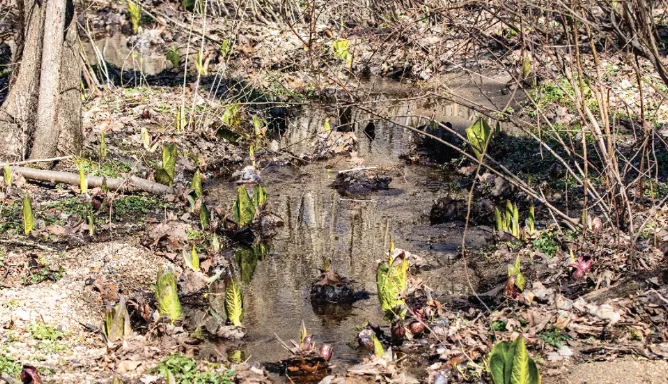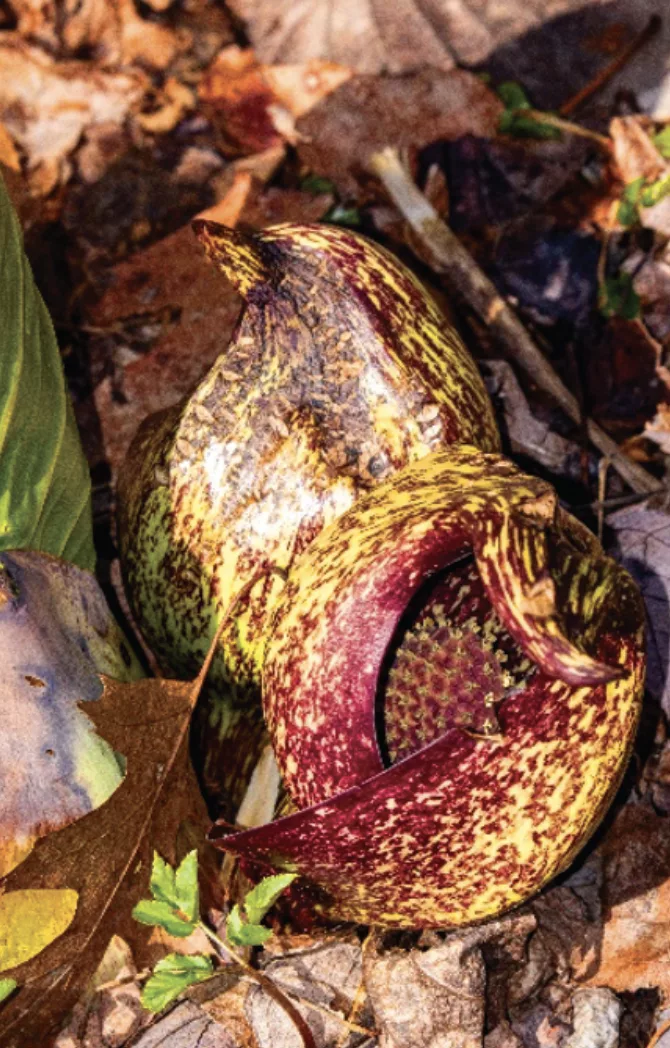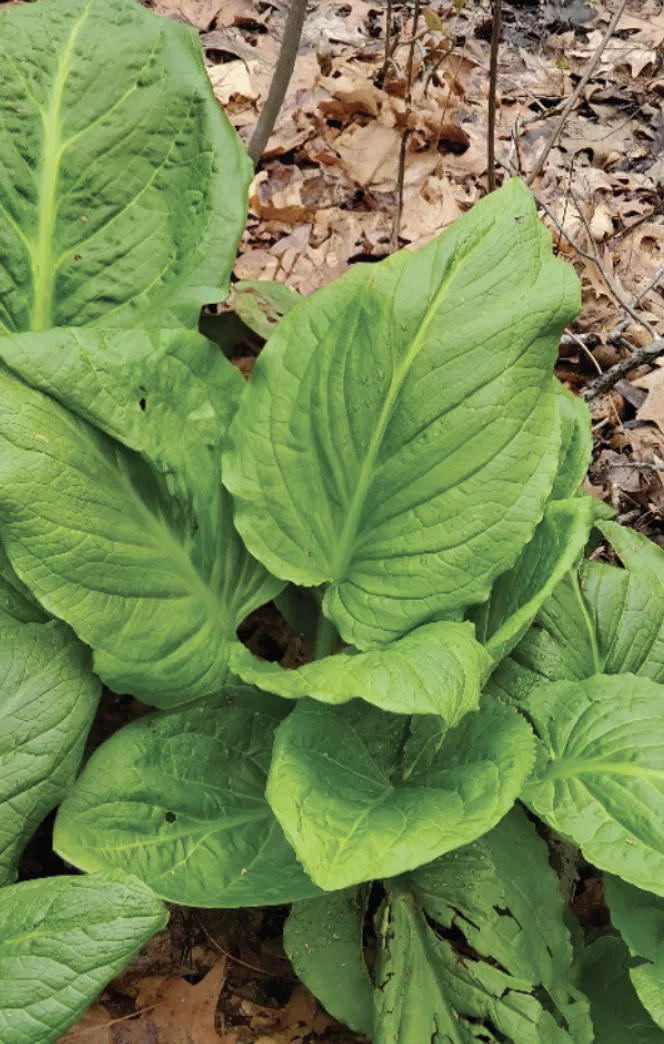By Frank Gallo
It’s almost Spring, and I’ve set out for a walk at the New Canaan Nature Center to see what I can find… The trail I’m on meanders through forest to a swamp where plants are beginning to emerge. As I draw near the wetland, I notice what looks like domed mottled purple monk’s hoods poking out through the mud and snow; these are the spathes, the leaf-like bracts containing the flower cluster or spadix of eastern skunk cabbage, (Symplocarpus foetidus) a plant known for its pungent odor. The enclosed spadix within this bizarre structure contains perfect flowers with both male and female reproductive parts. However, the flowers open asynchronously to prevent self-pollination. When the spathe first opens, the flowers are all females with ovaries then later transition into male flowers that produce pollen.
Skunk cabbage is an arum related to Jack-in-the-pulpit (Arisaema triphyllum) and wild calla lilies (Calla palustris) and only begins flowering in their seventh season. Our largest and earliest blooming spring wildflower, it often emerges in February when there is still snow cover. How is this possible?
Remarkably, skunk cabbage is thermogenic, one of a few plant species that produces its own heat through cellular respiration. During its two-week pollination stage, it increases its metabolism utilizing stored starches from its roots to produce heat. If the air temperature is above 37f, its internal temperature can rise as much as 30°f above the ambient temperature, quite enough to melt snow, allowing its spathe to emerge and flowers to be pollinated well before most other plant species.
What’s the advantage of flowering so early in the season? Plants compete for resources, including pollinators, and with few competitors so early in the year, skunk cabbage can capitalize on the available pollinator resource.
The spathe’s curved shape helps deflect air into the flower chamber, maintaining air flow and creating a warm microclimate and stable temperature. The higher temperature may help to increase the plant’s fetid odor which in turn attracts pollinators, often insects which are drawn to carrion such as blow flies and flesh flies.
Honeybees also utilize skunk cabbage both as an important early spring nectar and pollen source and as a refuge from the cold, especially on days when the temperature dips below 55 degrees Fahrenheit, their minimum flying temperature. The heat produced within the flower chamber allows them to warm and remain active.
Skunk cabbage are perennials. Their rootstalk, or rhizomes – underground stems with nodes from which roots emerge – is persistent and can survive for centuries. The rhizomes grow deep in the soil, and at the end of each growing season in late spring and early summer, the roots contract pulling the rhizomes even deeper into the soil. Thus, older plants have deeper rhizomes than younger. In undeveloped areas, skunk cabbage rhizomes may predate British colonization.
Black Bears readily eat skunk cabbage after immerging from hibernation, even though skunk cabbage leaves contain crystals of calcium oxalate making them unpalatable to most mammals, and highly toxic to humans, producing a stinging, burning sensation in the mouth when chewed raw. Native American’s and colonists utilized skunk cabbage for making medicines and at times for food after first drying the leaves completely.
If you’re curious about the strong odor that gives skunk cabbage its common name, make a small rip in a leaf and have a sniff. It smells less skunk-like and more fetid to my nose.
Further into the wetland, I spy a bright yellow flower with 5 petal-like sepals and heart-shaped leaves known as marsh marigold (Catha palustris), not a marigold at all, but a close cousin of buttercups (Ranunculus), that grows in rich wet areas. The flowers lack petals, and although the sepals appear bright yellow to our eyes, they contain bee purple which glows in the ultraviolet and is visible to insects. Bee purple coats the sepals except near their base providing insects with landing lights, as it were; the sepals dark base focuses their attention on the flower center where nectar and pollen await. Marsh marigold flowers open only when the sun is out and close at night and on cloudy days and will sometimes bloom again in autumn when light levels are like early spring’s.
Marsh marigolds are pollinated by syrphid flies (bee mimics), and a host of other flies and insects. Raw leaves are toxic, but young leaves are reported to taste like spinach after being boiled in several changes of water. Native American’s once boiled the iron-rich leaves to treat anemia.
As I approach a vernal pool farther along the trail, I hear the strident “peeps” of spring peepers, and the duck-like quacks of wood frogs. These Amphibians are the first frogs to emerge each year and are busy calling females to breed in these shallow temporary pools. If the water remains, in 6-8 weeks their young will leave the pools as tiny fully formed frogs and move into the forest in mass. I listen raptly to the chorus before moving on.
Although it is still early in the season, life is showing itself. More so each day. Soon fern fronds will be unfurling, bees buzzing, and birds singing, their chorus increasing daily as more and more species return from their winters away. And, as the days lengthen, a host of other ephemeral wildflowers will emerge and lend their beauty to the spring landscape. Each day there will be new wonders to uncover and places to explore. As I leave, I’m already looking forward to my next walk in the park.
Frank Gallo is the Senior Naturalist at the New Canaan Nature Center, 144 Oenoke Ridge, and the author of Birding in Connecticut – a comprehensive site. Email: Fgallo@newcanaannature.org. For more on the New Canaan Nature Center, visit Newcanaannature.org. All photos on this page are courtesy of Frank.




